The Carolingian Renaissance was the defining artistic movement of the Frankish Empire, during the rule of Charlemagne. Most Carolingian works, created in Central Europe, were produced for the emperor and his heirs.
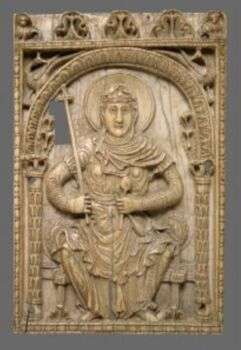
Image source: https://www.metmuseum.org/art/collection/search/464454?searchField=All&sortBy=Relevance&ft=Plaque+with+the+Virgin+Mary&offset=0&rpp=20&pos=1
Who were the Carolingian kings?
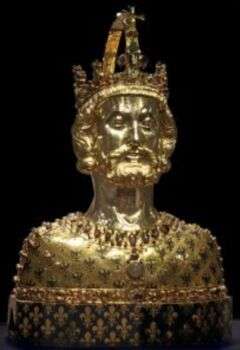
Image source: https://commons.wikimedia.org/wiki/File:Aachen_Domschatz_Bueste1.jpg
The Carolingian dynasty was the second Frankish dynasty founded by Charles Martel. The Carolingian Empire consolidated its power in the 8th century and extended over a large area that included West Germany, Gaul, the Alpine massif, and North Italy. The Carolingians were strongly influenced by the Byzantine style. Pope Stephen II legitimized the Carolingian empire by supporting the overthrow of the Merovingians. Further, the dynasty reached its peak in 800, after the crowning of Charlemagne. He was the first “Emperor of Romans” in the Western Roman Empire in over three centuries. In 814, he began to separate the Carolingian Empire, which lead to the creation of the Holy Roman Empire and the Kingdom of France.
Carolingian art
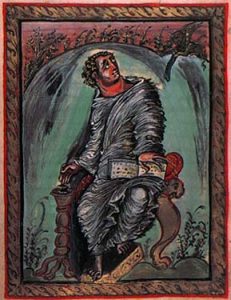
Image source: https://en.wikipedia.org/wiki/Carolingian_art
Carolingian Art, also known as the Carolingian Renaissance, was largely produced by the court circle and a small group of important monasteries. This circle shows the sophistication of design and an improvement in the quality of workmanship. Several centers, such as France, Austria, Germany, and northern Italy are home to the art created in this period. The Carolingian Renaissance shows the flourishing of culture after the barbarian invasions, as it revives classical Mediterranean art forms. The classical and Northern elements represent the human figures and set the stage for the rise of Romanesque and Gothic styles. By the 10th Century with the Cluny Reform, the production of art began again. New “Pre-Romanesque” styles developed in Germany with the “Ottonian art” and in England with the Anglo-Saxon art.
Illuminated manuscripts and metalwork
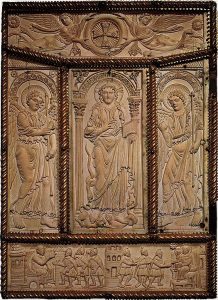
Image source: https://en.wikipedia.org/wiki/Carolingian_art
The most surviving works of the Carolingian dynasty are the illuminated manuscripts. These contained a few full-page miniatures, which include evangelist portraits and lavish canon tables. Luxury manuscripts were decorated with the treasure binding: a kind of ornate covers in luxury metal set with jewels around ivory panels. A few of the grandest manuscripts are on beautiful purple parchment. The Chronography of 354 was a Late Roman manuscript copied during the Carolingian period. Some historians thought that this copy has gone lost in the 17th century.
One of the important Carolingian examples of goldsmith’s work includes the higher cover of the Lindau Gospels. The precious cover of the Codex Aureus of St. Emmeram is dated to 870 and associated with the Holy Roman Emperor Charles II. Another example of Carolingian goldsmith’s work is the Golden Altar (824–859). The altar consists of four sides, decorated with different images in silver and gold and framed by filigree, rares stones, and enamel.
Mosaics and frescoes

Image source: https://en.wikipedia.org/wiki/Carolingian_art
Mosaics added value to the rich atmosphere of the Carolingian religious architecture. Many mosaics are present in religious buildings, depicted scenes, and other religious elements. Unfortunately, very few frescoes remain from this period. Some frescoes included religious versions of the battles of Charlemagne’s campaigns. Stone, stucco, sculptures, and reliefs were defining features of the Carolingian palaces and churches. The murals were often a life-size representation of spiritual scenes.
Carolingian architecture

Image size:https://en.wikipedia.org/wiki/Lorsch_Abbey
Carolingian architecture is reminiscent of Roman classicism, early Christian, and Byzantine styles. The gatehouse of Lorsch Abbey is an example of classical inspiration for Carolingian architecture. This building has a triple-arched hall with an arcade facade with columns and pilasters above. Columns and arcades on either side of the gatehouse resemble Roman Basilicas. Another surviving example of Carolingian architecture is the “Palatine Chapel.” This famous chapel, built with groin vaults and barrels, represent the late Roman methods of construction. The octagonal dome mimics the shape of San Vitale in Ravenna, Italy, which is a perfect example of Romanesque architecture.
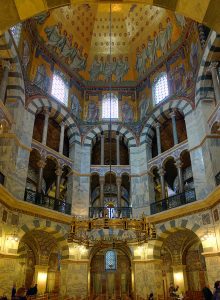
Image source: https://en.wikipedia.org/wiki/Palatine_Chapel%2C_Aachen
By the end of Charlemagne’s reign, the production of architectural projects increased. Some buildings integrated liturgical services and monastic architecture. The Plan of Saint Gall is a great example of how the architectural details of a Christian monastery defined a classic style.
The Carolingian dynasty left its mark on the world. The wealth they left behind gave power to future generations to create art and start religious movements.
Info source:
https://en.wikipedia.org/wiki/Carolingian_dynasty
https://www.britannica.com/place/France/The-Carolingians#ref464483
https://www.khanacademy.org/humanities/medieval-world/carolingian-ottonian/carolingian1/a/carolingian-art-an-introduction
http://expositions.nlr.ru/eng/ex_manus/europe_read/carolingian_ren.ph
phttps://www.theartist.me/art-movement/carolingian-art/
https://en.wikipedia.org/wiki/Carolingian_architecture
